Image Processing Reference
In-Depth Information
Reset signal conversion
Sensor signal conversion
Reset signal
Sensor signal
Pixel output
Ramp wave
(D/A output)
Agreement of ramp wave
and pixel output
Comparator
output
Up/down switching
Up/down
setting signal
PLL clock
Digital CDS
output
Down count start
Up count start
Counter
output
Reset signal
count
Sensor signal
count
Down counting
Up counting
FIGURE 5.57
Timing chart of digital CDS by single-slope integration. (Reprinted with permission from Nitta, Y., Muramatsu, Y.,
Amano, K., Toyama, T., Yamamoto, J., Mishina, K., Suzuki, A., et al.,
Proceedings of the IEEE International Solid-
State Circuits Conference, Digest of Technical Papers
, 27.5, pp. 2024-2031, San Francisco, CA, 2006.)
counter digitally subtracts conversion of the reset signal from the sensor signal, as shown
by counter output in Figure 5.57. In this way, the difference between the sensor and reset
signals is obtained in the digital domain, so it is called digital CDS. The obtained digital
data are transferred to data latches in each counter block. The horizontal data transfer and
A/D conversion of the next row are processed in parallel.
This configuration has the advantage of low-noise performance because of not only
highly accurate offset noise cancelation but also a lower band of frequency, thanks to A/D
conversion by column-parallel processing. By column-parallel A/D conversion, the sen-
sor achieves a high frame rate of 180 fps
44
in spite of the larger pixel number of 2.8 M. The
digital resolution is 12 bits. The noise of the electron number of column FPN by digital
CDS is reported to be 0.5.
As circuits of single-slope integrating type ADC are rather simple, they can be used
for narrow-pitch pixel sensors. They are suitable for image sensors because of their lower
power consumption. On the other hand, a significantly shorter conversion time is neces-
sary to increase the number of bits for digital coding. It is not easy to achieve both high
speed and high digital resolution.
5.3.3.2.2.2 Successive-Approximation-Type ADC
Successive-approximation ADC (SA-ADC)
is used as column ADC to realize high-speed conversion. Digital codes of all bits are
counted, starting from the most significant bit and finishing at the least significant bit. DAC















































































